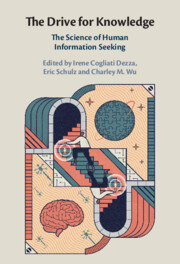Book contents
- The Drive for Knowledge
- The Drive for Knowledge
- Copyright page
- Contents
- Figures
- Tables
- Notes on Contributors
- Preface
- Part I What Drives Humans to Seek Information?
- Chapter 1 The Motivational Processes of Sense-Making
- Chapter 2 From Curiosity to Interest
- Chapter 3 Curiosity-Driven Exploration
- Chapter 4 Searching for Information, from Infancy to Adolescence
- Part II How Do Humans Search for Information?
- Part III Which Machinery Supports the Drive for Knowledge?
- Index
- References
Chapter 4 - Searching for Information, from Infancy to Adolescence
from Part I - What Drives Humans to Seek Information?
Published online by Cambridge University Press: 19 May 2022
- The Drive for Knowledge
- The Drive for Knowledge
- Copyright page
- Contents
- Figures
- Tables
- Notes on Contributors
- Preface
- Part I What Drives Humans to Seek Information?
- Chapter 1 The Motivational Processes of Sense-Making
- Chapter 2 From Curiosity to Interest
- Chapter 3 Curiosity-Driven Exploration
- Chapter 4 Searching for Information, from Infancy to Adolescence
- Part II How Do Humans Search for Information?
- Part III Which Machinery Supports the Drive for Knowledge?
- Index
- References
Summary
Recent research in cognitive development has supported and built on Piaget’s idea that children’s active engagement with the physical and social world is a crucial component to their learning. In this chapter we offer an overview of the latest results from developmental, cognitive, computational, and educational research on children’s exploration and information search. In particular, we examine the various forms active learning can take across the life span. We start by describing the development of increasingly sophisticated forms of information solicitation in infants and preverbal children, and then draw a developmental trajectory of the effectiveness of children’s exploratory and sampling strategies as well as of their question asking. In doing so, we touch upon three main themes: Children’s sensitivity to environmental inputs, their competence as active learners, and their adaptiveness in tailoring their active learning strategies to different environmental structures. To conclude, we discuss some of the most pressing open questions and promising avenues for future developmental research on active learning and information search.
- Type
- Chapter
- Information
- The Drive for KnowledgeThe Science of Human Information Seeking, pp. 77 - 98Publisher: Cambridge University PressPrint publication year: 2022
References
- 2
- Cited by



